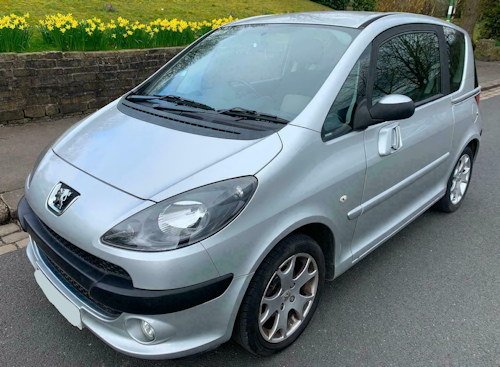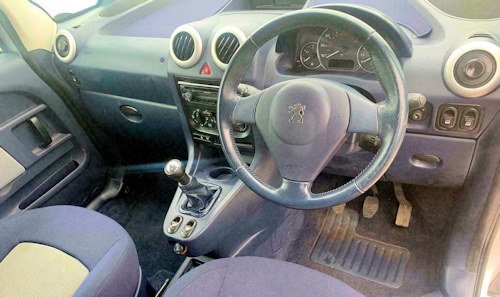Peugeot 1007
 |
|
|
Make |
Peugeot |
|
Years of production |
2005 - 2009 |
|
Production |
143,900 total |
|
Classroom |
motor car |
|
Engines |
Petrol |
|
Mixed consumption |
4.4 to 6.6 L / 100 km |
|
Emission of CO 2 |
115 to 156 g / km |
|
Bodywork (s) |
3 doors |
|
Length |
3,730 mm |
|
Width |
1,820 mm |
|
Height |
1,620 mm |
|
wheelbase |
2,320 mm |
The Peugeot 1007 is a Peugeot car primarily dedicated to urban travel and parking for four people, marketed from 2005 to 2009 .
History
The 3.73 meter long minivan was presented in the spring of 2002 at the Paris Motor Show as a study Sésame . Particularly striking were the two electrically operated sliding doors , which were also retained in the production vehicle.
With only 120,000 copies sold in four years The Peugeot 1007, 1007 was a commercial failure for Peugeot who prematurely ended his generation .
The 1007 is the first car in the world to have two electric sliding front doors. In Japan, the Toyota Porte , launched six months before the 1007, only has a sliding door on the passenger side. This concept was not followed up by Peugeot.
The interior Caméléo, available in twelve colors, changes "in fifteen minutes watch in hand", with eighteen pieces personalized for a supplement of 250 € . It is especially the two sliding doors, electric and remote controlled that mark the distinction of this model, allowing easy access and get in and out of his vehicle even when a parking space is narrow. These doors have an anti-pinch system which requires a strong pressure on the upper part . The front and rear seats have a rare modularity on this segment. The car was developed from the concept car "Sesame" presented at the Paris Motor Show 2002 and designed by Pininfarina SpA .

The 1007, however, suffered from some defects during its commissioning. The opening and closing times were long. Access to the rear seats was difficult. The chest was small. The first rather weak engines for a vehicle of nearly 1,400 kg in running order, gave it a reputation as a cramped and fuel-hungry vehicle. The decorative accessories to fix only added a touch of color to an interior (oil blue) too low-end. The high price was not justified compared to the services offered in terms of motorization, finish, modularity very below the average of its category (vehicles of an equivalent price).
In 2005, the car was awarded the EuroNCAP crash test with a record score of 36 points, only matched by the Citroën C5 , the Renault Laguna III and the Mercedes C-Class making it a benchmark for passive safety The robotised gearbox, dubbed "2-Tronic", allows two modes of shifting: one fully automated, which eliminates the manual passages in favor of a "free" driving, the other, sequential, which favors manual passages, by action on the gear lever or on the paddles under the steering wheel .
Three engines were planned at launch: a 1.4- liter, 75- hp petrol engine with a 5-speed manual gearbox or a 2-Tronic single-clutch robotic gearbox, a 1.6- liter 110- hp petrol engine with a 2-Tronic gearbox and a 1.4 liter diesel HDi of 70 ch with manual 5 reports. The limited power of the first engines gave the vehicle a clumsy drive that did not encourage sales.
Starting in April 2006, the 1.4- liter, 16-valve, 90- horsepower injection engine is offered. Then from February 2007 it is the 1.6 liter HDi that allows 1007 to benefit from a diesel engine more suited to its mass (more than one ton). This engine saves 4 seconds on the 0 to 100 km / h (11.4 s instead of 15.4 s for the 1.4 HDi 70 maximum speed 172 km / h) and offers a maximum torque between 240 and 260 Nm to 2,000 rpm thanks to the turbo with variable geometry.
An RC version with a 1.6 liter engine increased to 140 hp has never seen the light of day. Peugeot has just marketed a 1007 RC-Line, which takes the 1.6 liter gasoline 110 hp with a 5-speed manual and 2-Tronic for some countries and adds all the trim and decorations of crates of the 1007 RC presented at the 2006 Paris Motor Show .
The car was last offered (2009) with two petrol and diesel engines . Previously, there was also a 1.4 -l 16V gasoline engine with 65 kW (88 hp). All vehicles comply with the Euro 4 standard ; The diesel engine of the HDi FAP 110 with 80 kW has a particle filter (FAP, Filtre à particules). There is the 1.4 HDi with the emission standard Euro 3, 5L.
Special Series: Pack Limited (2005), Freddy (2005), Elle (2006, Belgium), Cappuccino (2006), Roxy (2006), RC Line (2006), Q uiksilver (2006, Switzerland), B lack & Silver ( 2009).
The 1007 saw its commercialization begin on April 28 , 2005. The vehicle was produced exclusively at the PSA factory in Poissy .
Technical
-
1.4 HDi 70
1.6 HDi 110
1.4 75
1.4 90
1.6 110
Engine
4 cylinders online
Displacement
1,398 cm 3
1 560 cm 3
1 360 cm 3
1,587 cm 3
Max power
68 hp at 4,000 rpm
109 hp at 4,000 rpm
73 hp at 5,400 rpm
75 hp at 5,500 rpm
88 hp at 5,250 rpm
90 hp at 5,500 rpm
109 hp at 5,750 rpm
110 hp at 5,750 rpm
Max torque
160 Nm at 2,000 rpm
260 Nm at 2,000 rpm
118 Nm at 3,300 rpm
120 Nm at 2,800 rpm
133 Nm at 3,250 rpm
120 Nm at 3,400 rpm
147 Nm at 3,900 rpm
Gearbox
BVM5
BVA
BVM5
BVA
BVM5
BVA
BVM5
BVA
Maximum speed
(in km / h)160
185
165
173
165
190
0- 100 km / h
15 s 4
11 s 4
14 s 4
16 s 6
14 s 4
13 s 6
14 s 4
11 s 8
11 s 1
11 s 8
11 s 8
Consumption
(in L / 100 km)4.7
4.8
6.6
6.3
6.4
6.6
6.9
6.6
CO 2 emissions
(in g / km)124
125
153
146
155
153
156
163
156
163
156
75
90
110
HDi 70
HDi FAP 110
Engine Type:
gasoline engine
diesel engine
Engine type:
Four-cylinder in Reihenbauart
Four-cylinder in-line design, turbocharger , common-rail injection
Valves per cylinder:
2
4
2
4
displacement:
1360 cm³
1587 cc
1398 cc
1560 cc
Max. Power at min -1 :
54 kW (73 hp) / 5400
65 kW (88 hp) / 5250
80 kW (109 hp) / 5750
50 kW (68 hp) / 4000
80 kW (109 hp) / 4000
Max. Torque at min -1 :
118 Nm / 3300
133 Nm / 3250
147 Nm / 4000
160 Nm / 2000
245 Nm / 1750
Drive type, standard:
front-wheel drive
Gearbox, standard:
5-speed manual transmission
Gear, optional:
automated 5-speed gearbox
-
automated 5-speed gearbox
-
Acceleration,
0-100 km / h:14.4 s [16.6 s]
13.6 s
11.1 s [11.8 s]
15.4 s
11.4 s
maximum speed:
165 km / h
173 km / h
190 km / h
160 km / h
190 km / h
Fuel consumption
per 100 km (combined,
according to EEC directive):6.5 l Super [6.3 l Super]
6,4 l super
6.5 l Super [6.6 l Super]
4.7 l diesel
4.8 l diesel
CO 2 emission,
combined:155 g / km [149 g / km]
163 g / km [156 g / km]
124 g / km
125 g / km
Emission standard according to
EU classification:Euro 4
tank capacity
40 l
Values in square brackets are for models with automated 2-Tronic 5-speed transmission
